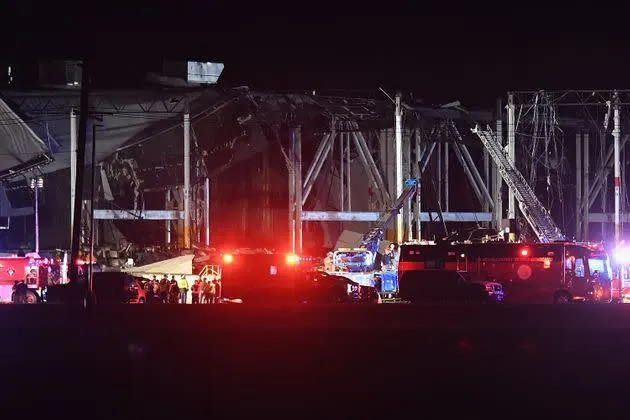“America’s Work Ethic,” an OtherWords.org cartoon by Khalil Bendib, Creative Commons License CC BY-ND 3.0
The Broad Sweep of Unrest
Some of the most notable strikes involve 10,000 John Deere production workers at plants in Iowa, Illinois, Kansas, Colorado, and Georgia; 1400 bakery and distribution Nabisco facilities; 1,100 miners at Warrior Met Coal in Alabama; 2,000 hospital workers at Buffalo’s Mercy Hospital; and 2,550 service workers in Cook County.
Some 24,000 nurses and health care workers at Kaiser Permanente in California and Oregon have also authorized a strike should an acceptable contract continue to be out of reach.
The Cornell tracker also charted 549 labor protests in 2021, referring to actions like informational picketing and lunch-hour protests that do not involve the withdrawal of labor. Furthermore, one can argue that the record number of workers quitting their jobs is yet another form of labor withdrawal. Forty-three million individuals left their jobs in August—a figure nearly 60 percent above the average since 2000.
This unrest is taking place in a political landscape where pro-labor elements of the Biden agenda are in limbo, with no sign of forward movement absent changes to the filibuster. But the reality is that singular reliance on governmental entities dominated by corporate interests has always been a bankrupt strategy for labor, and the recent rank-and-file militancy is plausibly a sign of union members having learned this lesson very well.
Motivations
The breadth and scope of unrest, and how it has been manifested across industries, makes it difficult to pinpoint all of its underlying causes and motivations. Certainly the pandemic has been a factor affecting key industries, often those with large concentrations of women and minority workers. Essential workers in health care and manufacturing faced long hours and often dangerous and abusive conditions, that had become more so during the pandemic. Restaurant workers faced wages below legally-mandated minimums and inadequate safety protocols once the businesses began opening again.
The pandemic also brought the problem of childcare for women workers into sharp relief. The crisis in access to quality care is undoubtedly one of the major causes of the much higher rate of women leaving the labor force.
Conservatives have argued that extended unemployment and related benefits offered during the pandemic were disincentives for workers to return to the labor market. But recent studies have shown that those states that ended these benefits early had fewer individuals return to the labor market than states that kept the benefits in place.
True to an enduring pattern in labor—the only exception being during the Great Depression—a labor shortage caused by labor market withdrawal has also increased the bargaining power of union workers. They can easily find other work and leave their employers, already having difficulty with staffing levels, in the lurch.
To understand the current militancy, however, a wider net must be cast. Since the 1970s worker pay has been largely stagnant, with workers disadvantaged by deindustrialization and too often by a labor leadership loathe to threaten their own enviable positions by rocking the boat. They were also often fearful that militancy might alienate tepid allies in a Democratic Party that since the Clinton years had largely abandoned a commitment to working-class voters. Meanwhile, corporate profits attained unprecedented levels; concessionary bargaining led to givebacks in wages and benefits; and constraints on employers’ ability to mistreat workers through production speedups, mandatory and uncompensated overtime, and harsh supervisory regimens all but vanished in many workplaces. Such are the underpinnings of an income inequality that has grown exponentially in the US in recent decades. These realities have inspired one commentator to accurately opine that what we are seeing in the current unrest is due to not a labor shortage, but a workers’-rights shortage.
Not surprising then that while covering strikes undertaken after rejections of tentative contracts recommended by union leadership, reporters have described the rank-and-file workers they interview as simply “angry, very angry.”
What Worker Anger Means for the Future
The labor unrest of this period gives cause for some optimism, as does new national survey data indicating that, at 68 percent, union favorability has reached its highest levels since 1965. The critical question will be whether this unrest and changing attitudes are channeled into strengthening collective mechanisms—including not just unions, but other innovative entities like worker centers. Even in the absence of a collective bargaining contract, these centers typically organize low-paid urban workers to fight employer practices like wage theft and failure to provide safe job sites.
It would be simplistic to suggest that the high level of job quits is a good sign for collective worker power in and of itself. Indeed, absent augmented collective worker power, it may be that individual decisions to leave the marketplace at best enhance only that individual’s limited personal fortunes and may be the start of a deterioration in living conditions for those who fail to find a better job.
One foreseeable task for unions and related institutions is to collect data on trends in quit patterns by firm to pinpoint those marked by high levels of turnover. Targeted organizing efforts could be focused on entities experiencing strong evidence of worker discontent. Putting more money and staff into organizing efforts should be a no brainer at this point.
Successful union organizing is often still a long shot in the US, due to an industrial relations regime that imposes miniscule penalties for unfair labor practices like firing rank-and-file organizers and fosters the ability of employers to use replacement workers in strike situations. Indeed, even some of the current strikes may still be at risk of loss if labor law reform is not soon achieved. Passing the federal PRO Act, which addresses issues of penalties and replacement workers, is a must.
But how to do it? As previously stated, the outlook for near-term passage is not favorable. It is possible that if labor unrest continues apace into 2022, interest in accommodating labor may increase, at least at the margins among legislators. An additional requirement is forceful union leaders at the national and local levels who have their fingers on the pulse of what the rank and file actually wants, who are truly committed to pursue rank-and file interest above their own, and, relatedly, who are not vulnerable to outside pressure (read blackmail, in select cases) from government and even employers due to their own corruption.
It is for these reasons that rank-and-file rebellions in the form of contract rejections are a truly hopeful sign, not least when they are complemented by rank-and-file movements to reform unions from within. Keep an eye on two recent examples of such efforts. The “One Member, One Vote” reform movement within the United Auto Workers aims at the direct election by the membership of International Executive Board officers, as opposed to the current system where officers are elected by convention delegates. Reformers see this change as one means for ending the corruption that has recently been exposed at the topmost levels of the union and for generating a more assertive leadership approach to collective bargaining. And the Teamsters United slate backed by Teamsters for a Democratic Union is making a bid to win a November election and put an end to years of wage and benefit givebacks to employers.
In the meantime, we can all help out striking workers in a variety of ways. See How to Support Striking Workers on the this ain’t livin’ blog (meloukhia.net).


















